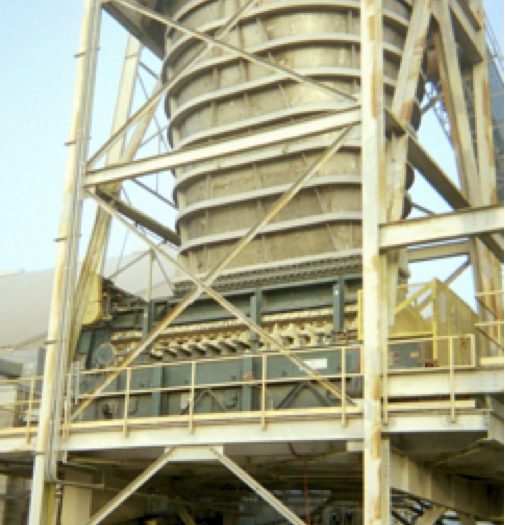
Cemex produces over 1 million metric tonnes of cement per year at their Clinchfield, Georgia (USA) plant. This capability is due in large part to a successful plant modernization and expansion that started with engineering in 1997 and finished with equipment commissioning in the spring of 1999. The “Clinchfield 2000 Project” resulted in a 50% increase in plant production capability at this former Southdown/Medusa-Citadel plant. Providing a continuous, uniform feed of sticky bulk solids like 20% moisture content limestone and 25% moisture clay was a major challenge and anticipated to create a process bottleneck.
As an outcome of discussions between plant personnel and Penta Engineering, Jenike & Johanson was contracted to develop functional design recommendations for the storage bins and feeders required to handle various raw materials at the plant so that the production capacity increase could be met.
The Solution
Two of the most common flow problems experienced in an improperly designed bin are arching (bridging) and ratholing. Arching occurs when an obstruction in the shape of a bridge forms above the outlet of a hopper and prevents any further material discharge. It can be an interlocking arch, where the particles mechanically lock to form the obstruction, or a cohesive arch, which occurs when particles pack together to form an obstruction.
Ratholing, which is common in bins handling a cohesive material, occurs when material flow takes place in a channel located above the hopper outlet. Materials, such as, limestone, gypsum, bauxite, clay, fly ash, and even cement often have sufficient cohesive strength such that the stagnant material located outside of this channel will not flow into it. Once the flow channel empties, all flow from the bin will stop. An erratic flow problem would negatively affect the efficiency of the new mill and would limit the production capacity increase at the Clinchfield plant.
Ratholing frequently occurs with a funnel flow pattern, in which some material moves while the rest remains stationary during discharge from the bin. Funnel flow occurs when the sloping hopper walls of a bin are not steep enough and low enough in friction for material to flow along them. Under these conditions, particles slide on themselves rather than the hopper walls, and an internal flow channel develops. Funnel flow is appropriate only when all of the following conditions are met: the material being handled consists mostly of coarse particles (usually 1/4 in. or larger); the material is free flowing; caking does not occur when particles are stagnant; and particle segregation is not a concern.
Most raw materials handled at a cement plant (e.g., clay, limestone, bauxite, gypsum, flyash, etc.) do not meet the above criteria. Bauxite, gypsum, and clays, which typically have high moisture contents (often greater than 10%), can be extremely cohesive. Caking can be a major problem with Portland cement.
Mass flow is defined as the flow pattern whereupon all of the material in a bin moves whenever any material is discharged. Mass flow occurs when sloping hopper walls are low enough in friction and steep enough for particles to slide along them. Mass flow eliminates ratholing, provides usable (live) capacity equal to the bin’s design volume, provides a first-in-first-out flow sequence, eliminates stagnant material (which can help minimize caking), and reduces sifting segregation. Mass flow bins with properly designed feeders ensure consistent flow (uniform bulk density) to downstream equipment, such as grinding mills. The improvement project team recognized that mass flow bins and properly designed feeders were critical to the success of the raw material handling project.
In order to achieve mass flow, two conditions must be met: the sloping hopper walls must be sufficiently steep and low enough in friction for the particles to slide along them and the hopper outlet must be large enough to prevent arching. Note that tests measuring the angle of repose of a bulk solid will not provide the information necessary to design a mass flow bin.
To determine the hopper angle and surface finish necessary to achieve mass flow, the friction that develops between the particles and the wall surface must first be measured in a laboratory using ASTM test method D 6128, in which a small sample of the bulk solid is placed in a test cell and sheared along a wall surface (e.g., stainless steel with #2B or #1 mill surface finish, or polyethylene liners).
The second requirement for mass flow is that the outlet must be large enough to prevent arching. Cohesive arching, can be analyzed by measuring the cohesive strength of the material. Tests are conducted using the ASTM method D 6128. Once the material’s strength is determined, minimum outlet sizes can be calculated using a series of design charts published by Andrew Jenike. A number of factors affect the minimum outlet required to prevent cohesive arching, including moisture content, particle size, and storage at rest for the bulk solid.
The test results eliminated the use of error prone guess-work commonly involved with hopper design. Additionally, the results clearly identified that if a funnel flow bin were implemented, then severe ratholing problems would occur, and as a costly consequence, material starvation to the mill would result.
Based on the cohesive strength test results for the clay (at an elevated moisture content), gravity discharge from a mass flow bin was unlikely, especially after overnight storage at rest. Therefore, a special bin was designed to handle the clay without convergence. This unique clay bins are shown in the adjacent photo.
In addition to steep, low friction hopper walls and sufficiently large outlets to prevent arching, mass flow requires that material flow take place through the entire cross-sectional area of the outlet. An obstructed outlet, such as due to a partially open slide gate, will result in funnel flow regardless of the hopper design. Likewise, it is imperative that a feeder be capable of withdrawing material from the entire outlet of the hopper. This is especially important when using a slotted outlet which requires that the feeder capacity increase in the direction of flow. When using a belt or apron feeder, this increase in capacity can be achieved by using a tapered interface.
The second photo illustrates the stack-up of a mass flow transition hopper, pin gate, feeder interface (located below pin gate), and apron feeder which is utilized to feed limestone into the grinding process. The apron feeder interface is critical for maintaining mass flow in a bin.
After completion of the conceptual designs and approval by improvement project personnel, Jenike & Johanson performed a material-induced loading analysis for each storage bin. This work involved calculating the structural loads applied by the material during initial fill and flow conditions. In the case of the mass flow limestone bin, the loads developing during flow are quite different that those resulting during initial fill, and if not anticipate, failure of the bin at the transition point (i.e., cylinder/hopper interface) could occur. By calculating this lateral load, structural engineers were able to properly design a compression ring beam required to resist buckling at the transition point.
In the case of the diverging geometry clay bins, the loads developed during flow are slightly different than those during initial fill; however both approach
a hydrostatic pressure distribution over the height of the bin.
The material-induced loads were critical for not only designing the steel structures, but also for calculating the normal and shear loads that are applied to the apron feeders. The apron feeder below the mass flow limestone bin has a significantly lower loading than that occurring with the apron feeder under the divergent geometry clay bin. This is principally due to the greatly reduced shear stress at the negatively sloping walls of the diverging clay bin, resulting in higher loads transmitted to the apron feeder.
The Result
As a result of the installed mass flow storage bins and apron feeders, Cemex has been able to provide reliable feed of the limestone and clay into the grinding process. Since the bins have been in operation, substantial time savings have been realized because operators are not required to use brute force methods (e.g., hammers, rods, etc.) in an attempt to initiate flow.
Furthermore, product and process quality improvements have resulted because of the consistent mill feed with each raw material. The key to the success of the bin designs was first knowing with a high degree of certainty how these bulk solids would behave as a function of the process conditions (moisture content, particle size, and storage at rest). The flow property test results were then utilized to develop proper bin geometry and apron feeder configurations necessary to maintain reliable flow.
Efficient operation of the vertical roller mill at the Clinchfield plant requires uninterrupted feed of the raw mix, thereby requiring a constant supply of limestone and clay, as well as other minor raw ingredients. Provided all of these bulk solids discharge reliably, the mill meets its performance capabilities and handles the grinding of the extremely wet materials far better than the previous mill; an additional major benefit of the new system is the elimination of the rotary dryer.
Antonio Deluca, the plant manager at Cemex Clinchfield, has recently confirmed that over the past decade, these bins and feeders have provided reliable discharge of the sticky limestone and clay, and additionally, similar mass flow bin and apron feeders designs have been implemented for other raw materials like raw mix, mill scale, and iron ore.






